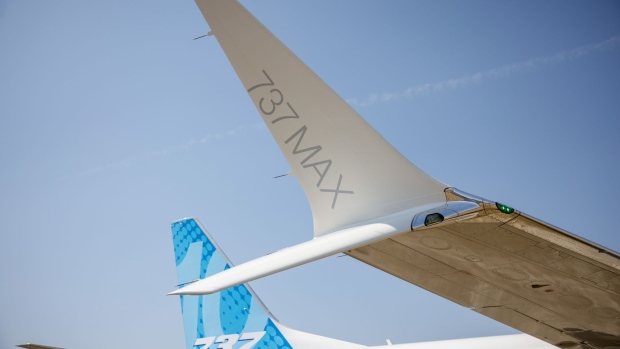Nov 29, 2022
Boeing (BA) 737 Max Models Could Be Certified Under Deal Discussed in Congress
, Bloomberg News

(Bloomberg) -- US lawmakers are discussing a compromise measure that would allow Boeing Co. to certify its final two 737 Max models without an expensive redesign while also adding new safety requirements.
Talks involving Senate and House lawmakers ramped up dramatically after the Thanksgiving holiday, and Senator Maria Cantwell of Washington, the Democratic chairwoman of the Commerce Committee, has floated a plan that would require an additional sensor system, people familiar with the talks said. The sensors are being tested on the Max 10, one of the jets in jeopardy of missing a late December certification deadline.
The proposal hasn’t been finalized and is opposed by some lawmakers and family members of passengers who died in the crashes of two 737 Max planes in 2018 and 2019, the people said. They asked not to be identified discussing the sensitive negotiations.
- Watch more: The story of how Boeing lost its way
Under existing law, Boeing would almost certainly have to revamp the cockpit alerting system in the Max 7 and Max 10 models unless Congress acts before a Dec. 27 deadline it imposed in legislation two years ago. It prohibits the Federal Aviation Administration from approving the design of any airliner that doesn’t have a modern system to help pilots track emergency warnings.
The stakes are high for Boeing if Congress doesn’t find an alternative. The company faces a multibillion-dollar redesign of the 737 flight deck and lengthy delay for its largest and smallest Max models. While Chief Executive Officer Dave Calhoun has threatened to scrap the stretched Max 10 if Congress doesn’t act, doing so would leave the US planemaker without a competitive response to rival Airbus SE’s top-selling A321neo models.
Lawmakers pressing to give Boeing more time are seeking to attach language to a bill in the next few weeks before Congress recesses for the holidays. One possibility would be to add it to legislation funding the Defense Department, which generally has broad, bipartisan support. A broader spending bill is another option.
Boeing’s shares rose 1.4% at 9:57 a.m. Wednesday in New York, the biggest gain in the Dow Jones Industrial Average. The stock fell 13% this year through Tuesday’s close, compared with a 17% decline for the S&P 500 Index.
Angle of Attack
Cantwell’s proposal would require adding equipment to calculate the so-called angle of attack, or whether a jet’s nose is pointed above or below the oncoming air. While the agreement isn’t complete, it could include adding such equipment to all Max models, two of the people said.
The Cantwell proposal would also require that Boeing give pilots an easy way to shut off certain cockpit alarms after determining they occurred in error. Regulators in Europe and Canada had earlier required such technology on the Max.
While details weren’t set, the proposal would require other Max models to have the same technology at some point after the Max 10 was completed, and to retrofit models already in service.
Boeing would have pay for any changes or retrofits related to the measure under the proposal.
A resumption of deliveries of currently certified 737 Max models has helped shore up the company’s cash flow, but investors have still been wary of regulatory scrutiny and manufacturing challenges.
Europe Agreement
Angle-of-attack sensors failed in both of the crashes involving Max jets, setting off the chain of events that led to the dives that killed 346 people. There are currently two such sensors on 737s, while some competing models have three.
The European Aviation Safety Agency got an agreement from Boeing to add a sensor system to the Max 10 model within two years before it decided to allow the Max family of aircraft to return to service after its grounding, but there is no such requirement in the US.
Adding the sensor system would improve safety by helping pilots diagnose a failure, EASA Executive Director Patrick Ky said in a 2020 interview.
Rather than add a new physical sensor, Boeing is testing a new system in the Max 10 that uses on-board computers to provide the reading.
“Our plan is to make it retrofit to the other members of the Max family,” Mike Fleming, a Boeing senior vice-president, told reporters during a June briefing. “And the pilot response from both our pilots and the customers has been very positive in terms of what they’ve seen. Number one, it is designed to eliminate most any of the erroneous indications that we think could happen on the airplane and two, it significantly reduces the pilot workload associated with any erroneous indication.”
FAA Administrator Billy Nolen said earlier this month that the agency believes it is required to halt work on certification of the two Max models unless Congress acts.
(Updates with share trading in seventh paragraph)
©2022 Bloomberg L.P.






